|
FAQs about Non-Vertebrate Animal Identification
13
Related Articles: Marine Invertebrates, Quarantine of Corals and
Invertebrates, Feeding
Reef Invertebrates, Lighting
Marine Invertebrates, Water Flow, How Much
is Enough,
Related FAQs: Non-Vert IDs 1, Non-Vert IDs 2, Non-Vert IDs 3, Non-Vert IDs 4, Non-Vert IDs 5, Non-Vert IDs 6, Non-Vert IDs 7, Non-Vert IDs 8, Non-Vert IDs 9, Non-Vert IDs 10, Non-Vert IDs 11, Non-Vert IDs 12, Non-Vert IDs 14, Non-Vert IDs 15, Non-Vert IDs 16, Non-Vert IDs 17, Non-Vert IDs 18, Non-Vert. ID 19, Non-Vert. ID 20, Non-Vert. ID 21, Non-Vert. ID 22, Non-Vert. ID 23, Non-Vert. ID 24, Non-Vert. ID 25, Non-Vert ID 26, Non-Vert ID 27, Non-Vert ID 28, Non-Vert ID 29, Non-Vert ID 30 Non-Vert ID 31, Non-Vert ID 32, Non-Vert 33, Non-Vert ID 34, Non-Vert ID 35, Non-Vert ID 36, Non-Vert ID 37, Non-Vert ID 38, Non-Vert ID 39, Non-Vert ID 40, Non-Vert ID 41, Non-Vert ID 42, Non-Vert ID 43, Non-Vert ID 44, Non-Vert ID 45, Non-Vert ID 46, Non-Vert ID 47, Non-Vert ID 48, Non-Vert ID 49, Non-Vert ID 50, Non-Vert ID 51, Non-Vert ID 52, Non-Vert ID 53, Non-Vert ID 54, Non-Vert ID 55, Non-Vert ID 56,
Non-Vert ID
57, Non-Vert ID 58,
Non-Vert ID 59,
Non-Vert ID 60, Non-Vert ID 61,
& Marine Invertebrates, Marine Invert.s 2, Marine Invert.s 3, & FAQs about:
Marine Invertebrate Behavior,
Marine Invertebrate
Compatibility, Marine
Invertebrate Selection, Marine
Invertebrate Systems, Feeding
Reef Invertebrates, Marine
Invertebrate Disease, Marine
Invertebrate Reproduction, &
LR Life
Identification, LR Hitchhiker ID
1, Anemone Identification,
Aiptasia
Identification, Aiptasia ID 2,
Worm Identification, Tubeworm ID, Polychaete Identification, Snail Identification, Marine Crab
Identification, Marine Invert.s 1,
Marine Invert.s 2, Marine Plankton,
|
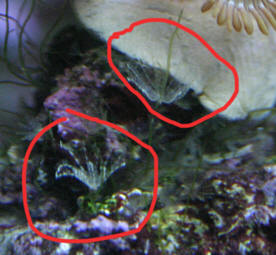
|
| Refugium Worm? Nope...Sponge ID - 02/03/2006 Dear Crew,
<Hello Marty.> I haven't been able to ID these guys in my
refugium. Started my tank 6 months ago. I have hundreds of these in
my refugium, appeared over the last few weeks. I hope the photo
quality is good enough for you to ID, <Pic. is fine.> it was
difficult to get close since they average about 5mm each. Thanks in
advance, Marty <You've got Syconoid sponges there Marty.
Nothing to worry about. - Josh> |
|
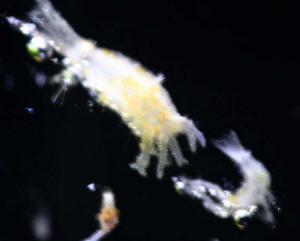
|
Creatures during cycling 1/31/06 Hi everyone!
Excellent site! Extremely helpful to this newbie. Finding & using
your site has assisted me in planning out my reef before buying any
creatures (light req etc.) Thks. <Good, and welcome> Anyway my
question is this. I am currently cycling my 55 gal set-up. Last week I
had my LFS test my water everything good! <Better... to have/use
your own test kits> Ready to go. I'm still waiting to purchase
my lighting and will be doing so next week. In the meantime there are
creatures "swimming" in my tank already and I was wondering
if you could help with an ID. Checked all the faq's couldn't
find any like it. <There are literally hundreds of thousands of
possibilities...> I can only describe the as follows. They look like
a racquetball "birdie" and swim in a motion similar to an
octopus or jellyfish. The bottom pulses and they move around.
<Medusae of some sort... cnidarians likely> They are VERY small
perhaps slightly larger than the period . on this page. Any Ideas?
Another critter is in there that is a tiny bit bigger and swims just
like a fish? And finally one last thing in there. I can only describe
it like a dandelion pedals (like the ones you blow off the flower as a
child) they are on the sides of the glass. Sorry to bother you with
what I'm sure are total novice questions. Thanks for any assistance
and for your wonderful website! Spud <Nice general descriptions, but
as stated... many possibilities. All very likely transient and of no
dire consequences. Enjoy the cavalcade as your lives pass. Bob
Fenner>
| Is this a coral? 1/21/06 I am having real
difficulty identifying this. HYPERLINK " http://img.photobucket.com/albums/v349/gavnnik/a8a3ef1e.jpg"
http://img.phot
obucket.com/albums/v349/gavnnik/a8a3ef1e.jpg I've asked on
several Forums but to no avail. Initially it looks like
some sort of elongated mushroom but it doesn't have the right
'texture' and this part was cut from a parent that is
perhaps 8-9' long. The closest picture I can find in
any book is a Myrionema (Hydroid)? Do you have any suggestions?
Gavin <Is it soft to the touch? Could be a cnidarian... or a
sponge... Do you have access to a low-power microscope? Bob
Fenner> |
|
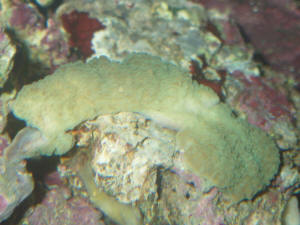
|
ID + compatibility 1/18/06 Hi WWM Crew,
<Hello Jeff> After reading and researching your site for
almost a year, I have finally setup my first reef aquarium. If it
wasn't for "Nemo's" my wife would never have said
yes. <I believe "Nemo" has sparked many new tanks.>
If it wasn't for your entire crew's diligence, passion and
"Godlike" knowledge ;-), it never would have come to
fruition. Thanks a couple thousand! I will be taking part in the
Honor System shortly to help you maintain the site. Keep up the
amazing effort. <Glad to hear.> I am sad to say that I just
did a disappointing thing about 1 hour ago. I noticed my false
percula swim after some debris and "wince" then spit it
out again. I thought this was strange and for some reason thought
it looked like it was stung. Well a short while later I saw the
piece again. My shock...a jellyfish. I quickly got my turkey
baster and sucked it up, then poured it into a clear cup and took
pictures. I never would have guessed that I should keep it, I
actually watched it for a while in wonder.......and then poured it
down the drain. Only after that did I research the little critter
and found the exact same guy on the faq. It was a bonus not a
problem. Oh well, I definitely won't do that again before
researching WWM. It is amazing that in such a short amount of time,
8 weeks since the LR arrived, 4 weeks since placing it into my
system, that the substrate is already coming alive with flatworms
and other small critters. My wife always shakes her head when she
sees me kneeling on the floor with magnifying glass (or two) to
look at the bio diversity (& unfortunately Aiptasia) that are
coming back. <I understand this quite well. My wife
thinks I look like the detective from the Pink Panther movie.>
30 gallon 1 65 w PC 10000K + 1 65w PC True Actinic Remora Skimmer
(good amt of dark skimmate) 2 Aquaball powerheads 2 75 watt heaters
3-6" aragonite (varies) Tropic Marin Pro Reef Salt spg 1.025
ph 8.2 Alkalinity good (according to instructions, I just forget
what it read) 10% water changes every 5-7 days with some gravel
cleaning, more vacuuming the LR actually. <Vacuuming is a good
practice, definitely helps keep nitrate levels down.> 2 juvenile
ocellaris clowns 2 cerith snails, 2 Nerite snails and 2 ?Margarita?
snails 3 red leg hermits + 3 blue legged (neat critters, though I
now think I should have left them out of the equation) <Why?>
First question, I am adding more live rock in a few weeks, it is
curing as I write this, do bring my amount to just over a lb per
gal. Other than curing/qt is there any other precaution I need to
take before finally putting into my display tank? <Do keep an
eye out for mantis shrimp that may have been hitchhiking.>
Next... I am using FasTest tests to test my ammonia, nitrites etc.
In the entire time I have had the system and during the curing
process I only once detected ammonia and never nitrites, or
phosphates. Is this real? <Nitrite isn't present near as
long as ammonia.> The LR definitely stunk before it cured and I
assumed I should get a reading on at least ammonia. <Yes> All
I had setup was a 10 gallon tub with a powerhead, heater and a
AquaClear filter (sponge and charcoal only). Never a detectable
reading in the main system either, even though I know I started out
feeding the 2 clowns too much. I intend to purchase a citron goby
in a while. I am also considering a jawfish (yellow head
preferably) much later but I am getting the impression that in such
a small bottomed tank that the two may not work well together. Your
opinion? <Jawfish like 5 to 7" of sand (mixed sizes) to
feel at home as they do burrow. I'd nix this for
now.> I also really like the blue/yellow damsel my LFS had.
Would it work to have these five in my system? I eventually want
some soft corals and button polyps. <These guys are semi
aggressive and with your clowns I wouldn't mix them especially
in a 30 gallon. Consider a Dottyback or another
goby.> I have two photos attached of a couple of neat finds I
can't find to ID on the web. The hitchhiker on my snail looked
like another spike, but the wrong placement, then it stuck out its
black mouth and began to eat, how cool is that, lazy but cool. I am
just wondering if you can ID it for me. Also, my LFS told me the
host was a margarita snail, right or not I can't positively ID
so far. <Without seeing the topside of the snail it looks like
an Astrea caelata or Astrea phoebia (star snail).> The other
picture is a very tiny and almost imperceptible "worm"
that I saw. It moved like it was only a piece of debris, but it was
definitely hunting. It looked like a microscopic string of pearls
about 1/2" long with a head that appeared to have several
appendages. Never swam only moved along the rock. I have not seen
it again. I am guessing that it is a larvae of some sort. <I
can't ID it but I'm sure it's
harmless. Maybe Bob can ID it.> Well that is a lot, I
hope I didn't go overboard. Thanks again for all that you do
for the masses. <You're welcome and DO keep reading WWM,
much to be learned. James (Salty Dog)> Jeff
Morgan
Edmonton, AB Canada |
|
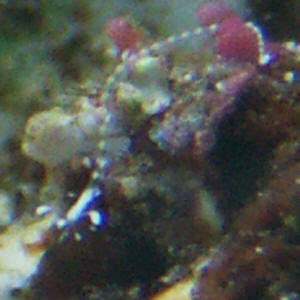 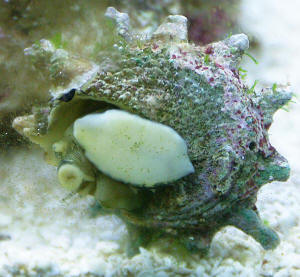
|
| Tiny thing ID 1/18/06 Sorry, it won't
let me send this movie (the file's 15 mb). I'll
try to either shorten it or take another one next time I see the
critter. Here's a still picture, in case you can do it this
way. DPM PS it's tiny -- when fully extended maybe 1.5 cm.
Daniel <Mmm, looks like some sort of crustacean... does it move
as such? Could be a mollusk... Bob Fenner> |
|
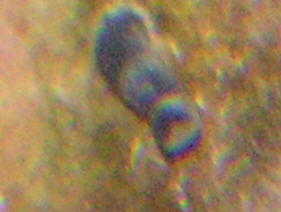
|
| No, it moves more like it's a worm attached at the
base. It reaches out and seems to grab stuff with its
free end (as if it's picking something tiny off of the LR).
<Ahh! A worm of some sort... a "head shot" with a
macro rig will come in handy for more close-up pix. Bob
Fenner> |
| Something is taking over! 1/17/06 Greetings
from the frozen North, <A bit warmer here, little doubt, in S.
Cal.... though I wish we were diving in the tropics...> Please
have a look at the attached photo. These little white or
semi-translucent "tree armatures" are taking over my 35G
FOWLR tank. They started appearing over one year ago, and slowly
spreading. They seem to like to darker areas of the tank (underside
of the live rock, less traveled areas). They only attach to the
live rock and not to sand or glass. My questions are: 1: What are
they? <Do look like some type of branching hydroid,
hydropolyp... trouble> 2. How can I get rid of them. <I would
remove all else and treat the system with copper...> There are
too many to manually remove, and they seem to like the hard to
reach crevices. I have heard them compared to
"Holothurian Tentacles", but do not see the resemblance.
<And they're attached... not moving... not holothuroids>
Thank you very much for all the help you provide. Jeremy Jordan in
West Michigan <I do hope you have another suitable system... Bob
Fenner> |
|
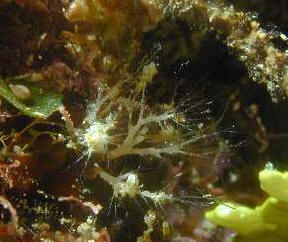
|
Polyp, crustacean ID? Hello! I have these orange
disked bodies that have a mouth directly in the center of them (they
only are visible at night when I have a flash light) anyway... they
seem to have legs (the diameter of a human hair) and a tiny ball
(yellowish in color) on the end of each hair...I keep searching to see
what they are and after weeks of reading I thought I would ask to see
if you knew what they are....I only saw one at first....now months
later...they are multiplying...I believe I have about 8-9 of them
now..... Any idea what they are? Thanks...Kelly <Mmm,
nope. Please send along a photo. Bob Fenner> Unknown suction
mouth type critter ... and? James... pic, file not saved Hi all,
<Hello Jim, nice name> This is my first post because after much
searching I could not find my mystery critter on your
site. It all started when I purchased my flame scallop. (I
know, I wasn't entirely informed on the mortality rates in
captivity) The first day we got him home, I noticed a
cluster of these 'algae looking' little shoots sticking out of
his shell near the hinge. They soon detached and were
attached to the glass with a suction-type mouth. I never see
them move other than swaying in the current, but each morning I can see
a new one where the scallop had previously been the day
before. At first I thought they might be some kind of macro
or symbiotic algae living within the scallop. They are almost a
reflective green color with no segments of any kind and tapering off at
the tail to a gentle point. Hard to photograph, took about
25 tries. Each one seems to be about 1 1/4" to 1
1/2" long. They are only attached to the glass and my
undergravel filter tube at the moment, but I would rather find out what
they are before they perhaps multiply?? <I'm pretty sure what
you are looking at is the means by which the scallops
"anchor" themselves, normal observation.> Sorry for the
length of this email, but like I said, this is my first post and I had
a few other questions as well. First, can you tell from the
picture what it may be? <As above> Second, I have a growing
population of bristle worms in my crushed coral substrate, as well as
lots of micro stars, pods, etc. Wondering if I should try to remove
some of the bristle worms as they are seeming to multiply pretty
readily. <If they are the smaller species they are quite beneficial,
the larger ones are taboo. If the later is the case, I'd
get a worm trap and start removing these guys.> My
livestock include a Coral Beauty, a Gold Stripe Maroon Clown, a
Chocolate Chip Starfish,<Not a good reef candidate> an Arrow
Crab, a Flame Scallop, a Bubble Tip Anemone (the clown LOVES it!), a
Curlicue Anemone, about 50 snails and 30 hermits. I have
even noticed 6 baby turbo snails lately, each smaller than a
pea. (very cute!) My water test have been pretty
good in my opinion. Ammonia 0, Nitrite 0, Nitrate 10,
Calcium 420, PH 8.2 I have a 45 gallon tank in which I do a
5 gallon water change weekly. <Good practice> I have a very well
growing basketball sized piece of Caulerpa serrulata in the tank due to
not having a sump or refugium, a Remora Pro protein
skimmer,<Good choice> Aquaclear 300 hang-on filter, and 2
powerheads for the undergravel filter <Do vacuum the gravel during
water changes, especially using a UGF. If you have live rock
I'd consider getting rid of the UGF altogether and use the live
rock for the biological filter.> My lighting is a single
lamp, 96W Compact Fluorescent 50/50 bulb.<Not enough light for your
anemones.> Feel free to shorten this post if necessary to get to the
point if need be. By the way, send my thanks to
Bob for writing such a great book as his Conscientious Marine
Aquarist! I am about halfway through it now. <Bob does
thank you for the purchase. <<Another 28 cents, Ooh yeah!
RMF>> Consider using DT's Live
Phytoplankton. The lifespan of the scallop will be greatly
increased. James (Salty Dog)> Thanks in advance for the
help! <You're welcome> Jim
Aiptasia, Hydroid, or Other? - 01/12/2006 Hello, <Hi
Craig.> Thank you for providing an excellent resource. <We
love being a part of it!> For the last few months I have
observed about 5 of these in my reef tank. They have not grown past
1/8-1/4 inch high and about 1/4 inch wide at the top of the crown.
Tonight I have counted around 10-15 and am concerned that it may be
Aiptasia, though it does look different than the photos on your
site. Please let me know if you can provide a positive id as to
what it is (circled in red). <Well, I can't be positive, but
they actually look more like a type of featherduster. Do they have
a distinct oral disc? If so then they are likely Aiptasia, if not
they are likely just common Polychaete worm.> Thanks,
Craig <Gladly. - Josh> |
|

|
|
|

